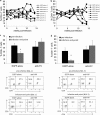Generation of an HIV-1-resistant immune system with CD34(+) hematopoietic stem cells transduced with a triple-combination anti-HIV lentiviral vector
- PMID: 22398281
- PMCID: PMC3347262
- DOI: 10.1128/JVI.06300-11
Generation of an HIV-1-resistant immune system with CD34(+) hematopoietic stem cells transduced with a triple-combination anti-HIV lentiviral vector
Abstract
HIV gene therapy has the potential to offer an alternative to the use of current small-molecule antiretroviral drugs as a treatment strategy for HIV-infected individuals. Therapies designed to administer HIV-resistant stem cells to an infected patient may also provide a functional cure, as observed in a bone marrow transplant performed with hematopoietic stem cells (HSCs) homozygous for the CCR5-Δ32-bp allele. In our current studies, preclinical evaluation of a combination anti-HIV lentiviral vector was performed, in vivo, in humanized NOD-RAG1(-/-) IL2rγ(-/-) knockout mice. This combination vector, which displays strong preintegration inhibition of HIV-1 infection in vitro, contains a human/rhesus macaque TRIM5α isoform, a CCR5 short hairpin RNA (shRNA), and a TAR decoy. Multilineage hematopoiesis from anti-HIV lentiviral vector-transduced human CD34(+) HSCs was observed in the peripheral blood and in various lymphoid organs, including the thymus, spleen, and bone marrow, of engrafted mice. Anti-HIV vector-transduced CD34(+) cells displayed normal development of immune cells, including T cells, B cells, and macrophages. The anti-HIV vector-transduced cells also displayed knockdown of cell surface CCR5 due to the expression of the CCR5 shRNA. After in vivo challenge with either an R5-tropic BaL-1 or X4-tropic NL4-3 strain of HIV-1, maintenance of human CD4(+) cell levels and a selective survival advantage of anti-HIV gene-modified cells were observed in engrafted mice. The data provided from our study confirm the safety and efficacy of this combination anti-HIV lentiviral vector in a hematopoietic stem cell gene therapy setting for HIV and validates its potential application in future clinical trials.
Figures







References
-
- Anderson J, et al. 2007. Safety and efficacy of a lentiviral vector containing three anti-HIV genes—CCR5 ribozyme, tat-rev siRNA, and TAR decoy—in SCID-hu mouse-derived T cells. Mol. Ther. 15:1182–1188 - PubMed
-
- Anderson J, Akkina R. 2007. Complete knockdown of CCR5 by lentiviral vector-expressed siRNAs and protection of transgenic macrophages against HIV-1 infection. Gene Ther. 14:1287–1297 - PubMed
-
- Anderson J, Akkina R. 2008. Human immunodeficiency virus type 1 restriction by human-rhesus chimeric tripartite motif 5alpha (TRIM 5alpha) in CD34+(+) cell-derived macrophages in vitro and in T cells in vivo in severe combined immunodeficient (SCID-hu) mice transplanted with human fetal tissue. Hum. Gene Ther. 19:217–228 - PubMed
Publication types
MeSH terms
Substances
Grants and funding
LinkOut - more resources
Full Text Sources
Other Literature Sources
Medical
Research Materials

